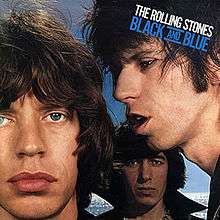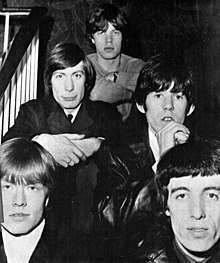Black and Blue
Black and Blue is the 13th British and 15th American studio album by the band the Rolling Stones, released in 1976.
| Black and Blue | ||||
|---|---|---|---|---|
 | ||||
| Studio album by | ||||
| Released | 23 April 1976 | |||
| Recorded |
| |||
| Studio |
| |||
| Genre | ||||
| Length | 41:24 | |||
| Label | Rolling Stones | |||
| Producer | The Glimmer Twins | |||
| The Rolling Stones chronology | ||||
| ||||
| Singles from Black and Blue | ||||
| ||||
This album was the first recorded after former guitarist Mick Taylor quit in December 1974. As he had done the previous time the Stones were between second guitarists in 1968, Keith Richards recorded the bulk of the guitar parts himself, though the album recording sessions also served as an audition for Taylor's replacement. Richards said of the album that it was used for "rehearsing guitar players, that's what that one was about."[2] Numerous guitarists showed up to auditions; those who appeared on the album were Wayne Perkins, Harvey Mandel, and Ronnie Wood. Wood had previously contributed to the title track from the It's Only Rock 'n Roll album, and would become a full-time member of the Stones in 1976. The Stones rhythm section of bassist Bill Wyman and drummer Charlie Watts appear on nearly all tracks, and frequent collaborators Nicky Hopkins and Billy Preston play keyboards on most of the album, with percussionist Ollie E. Brown also appearing on about half of the tracks. The album was the second to be self-produced, credited to "The Glimmer Twins", a pseudonym used by Jagger and Richards for their roles as producers.
Black and Blue showed the band blending its traditional rock and roll style with heavy influences from reggae and funk music. Only one single from the album, "Fool to Cry", had any significant chart success, and criticism of the album was mixed. The album received a few positive reviews at the time of release, though many reviewers found it mostly forgettable, and tended to rank it very low compared to prior Stones releases. Retrospective reviews from more recent publications such as AllMusic have been kinder to the album, with critic Stephen Thomas Erlewine stating that the album's "being longer on grooves and jams than songs" ended up being "what's good about it".[3]
History
The Rolling Stones returned to Munich, Germany, in December 1974—where they had recorded their previous album It's Only Rock 'n' Roll—and began the recording of their new album at Musicland Studios, with Mick Jagger and Keith Richards (as the Glimmer Twins) producing again. With a view to releasing it in time for a summer 1975 Tour of the Americas, the band broke for the holidays and returned in January in Rotterdam, Netherlands, to continue working—all the while auditioning new guitarists as they recorded. Among the hopefuls were Steve Marriott, Harvey Mandel, Wayne Perkins, Peter Frampton, and Ronnie Wood (although only Mandel, Perkins and Wood's guitar work would appear on the finished album). Guitar heroes Rory Gallagher and Jeff Beck both went over for a jam with the band "just to see what was going on," but both declined interest in joining the group, happy with their solo careers. Jeff Beck stated that, "in two hours I got to play three chords – I need a little more energy than that." With much work to follow, it was decided to delay the album for the following year and release the Made in the Shade compilation instead. "Cherry Oh Baby" (which was a cover version of Eric Donaldson's 1971 reggae song) would be the only song from the upcoming album sporadically played on the 1975 Tour of the Americas.
Following the conclusion of the tour, the band went to Montreux, Switzerland, in October for some overdub work, returning to Musicland Studios in Munich in December to perform similar work. After some final touch-ups, Black and Blue was completed in New York City in February 1976. That month the Stones flew to Sanibel Island Beach on Sanibel Island, Florida, to be photographed by fashion photographer Hiro for the album cover art.[4]
Stylistically, Black and Blue embraces hard rock with "Hand of Fate" and "Crazy Mama"; funk with "Hot Stuff"; reggae with their cover of "Cherry Oh Baby"; and blues with "Melody," featuring the talents of Billy Preston – a heavy contributor to the album. Musical and thematic styles were merged on the seven-minute "Memory Motel," with both Jagger and Richards contributing lead vocals to a love song embedded within a life-on-the-road tale.
While all the album's songs except "Cherry Oh Baby" were officially credited to Jagger/Richards as authors, the credit for "Hey Negrita" specifies "Inspiration by Ron Wood" and "Melody" lists "Inspiration by Billy Preston". Bill Wyman would later release a version of "Melody" with his Rhythm Kings, crediting Preston as author.
Two extra tracks recorded in the Rotterdam sessions were later released on 1981's Tattoo You: "Slave" and "Worried About You".[5]
Release and reception
| Review scores | |
|---|---|
| Source | Rating |
| AllMusic | |
| Christgau's Record Guide | A–[6] |
| The Great Rock Discography | 6/10[7] |
| MusicHound | 3/5[8] |
| NME | 7/10[9] |
| The Rolling Stone Album Guide | |
| The Village Voice | A–[11] |
| Tom Hull | B+[12] |
Released in April 1976 — with "Fool to Cry", a worldwide top 10 hit, as its lead single — Black and Blue reached No. 2 in the UK and spent an interrupted four-week spell at number 1 in the United States, going platinum there.
The album was promoted with a controversial billboard on Sunset Boulevard in Hollywood that depicted the model Anita Russell, bound by Jagger[13] under the phrase "I'm Black and Blue from the Rolling Stones – and I love it!" The billboard was removed after protests by the feminist group Women Against Violence Against Women, although it earned the band widespread press coverage.[14]
Critical view was polarised. Lester Bangs wrote in Creem that "the heat's off, because it's all over, they really don't matter anymore or stand for anything [...] this is the first meaningless Rolling Stones album, and thank God".[15] However, Robert Christgau gave the album an A-, commending the band for taking risks. Christgau singled out "Hot Stuff" and "Fool to Cry" for particular praise before concluding: "diagnosis: not dead by a long shot".[16]
In 2000 it was voted number 536 in Colin Larkin's All Time Top 1000 Albums.[17]
In 1994, Black and Blue was remastered and reissued by Virgin Records, again in 2009 by Universal Music, and once more in 2011 by Universal Music Enterprises in a Japanese-only SHM-SACD version. The 1994 remaster was initially released in a Collector's Edition CD, which replicated in miniature many elements of the original gatefold album packaging.
Track listing
All tracks are written by Mick Jagger and Keith Richards, except where noted.
| No. | Title | Writer(s) | Length |
|---|---|---|---|
| 1. | "Hot Stuff" | 5:20 | |
| 2. | "Hand of Fate" | 4:28 | |
| 3. | "Cherry Oh Baby" | Eric Donaldson | 3:57 |
| 4. | "Memory Motel" | 7:07 |
| No. | Title | Writer(s) | Length |
|---|---|---|---|
| 5. | "Hey Negrita" | inspiration by Ron Wood | 4:59 |
| 6. | "Melody" | inspiration by Billy Preston | 5:47 |
| 7. | "Fool to Cry" | 5:03 | |
| 8. | "Crazy Mama" | 4:34 |
Personnel
The Rolling Stones
- Mick Jagger – lead vocals (all tracks), backing vocals (1, 3, 4), percussion (1), piano (4), electric piano (7), electric guitar (8)
- Keith Richards – electric guitar (all but 4), backing vocals (1-5, 8), electric piano (4), bass guitar (8), piano (8), co-lead vocals (4)
- Ronnie Wood – backing vocals (1, 2, 4, 5, 8), electric guitar (3, 5, 8)
- Bill Wyman – bass guitar (all but 8), percussion (1)
- Charlie Watts – drums (all tracks), percussion (1)
Additional personnel
- Billy Preston – piano (1, 2, 5, 6, 8), organ (5, 6), synthesizer (4), percussion (6), backing vocals (1, 4, 5, 6),
- Nicky Hopkins – piano (7), synthesizer (7), organ (3)
- Harvey Mandel – electric guitar (1, 4)
- Wayne Perkins – electric guitar (2, 7), acoustic guitar (4)
- Ollie E. Brown – percussion (1-3, 5, 8)
- Ian Stewart – percussion (1)
- Arif Mardin – horn arrangement (6)
Technical
- Engineers – Keith Harwood, Glyn Johns, Phil McDonald, Lew Hahn (edit)
- Assistant engineers – Jeremy Gee, Dave Richards, Tapani, Steve Dowd, Gene Paul
- Lee Hulko – LP mastering at Sterling Sound (original 1976)
- Robert Ludwig – CD mastering at Gateway Mastering Studios (1994 Virgin issue)
- Bea Fleiter – art director[18]
Charts
Weekly charts
Singles
|
Certifications
| ||||||||||||||||||||||||||||||||||||||||||||||||
References
- Overdub work 1975 and 1976
- Hector, James (1995). The Complete Guide to the Music of The Rolling Stones. London: Omnibus Press. p. 101. ISBN 0-7119-4303-6.
- link
- "Led Zeppelin Crashed Here – The Rock and Roll Landmarks of North America" by Chris Epting, p. 109
- "Slave" and "Worried About You" recorded during sessions in January–February 1975
- Christgau, Robert (1981). "Consumer Guide '70s: R". Christgau's Record Guide: Rock Albums of the Seventies. Ticknor & Fields. ISBN 089919026X. Retrieved 9 March 2019 – via robertchristgau.com.
- Strong, Martin C. (2006). The Great Rock Discography. Edinburgh, UK: Canongate. p. 993. ISBN 978-1841956152.
- Graff, Gary; Durchholz, Daniel (eds) (1999). MusicHound Rock: The Essential Album Guide. Farmington Hills, MI: Visible Ink Press. p. 952. ISBN 1-57859-061-2.CS1 maint: extra text: authors list (link)
- "The Rolling Stones – Black and Blue CD". CD Universe/Muze. Retrieved 15 November 2014.
- "The Rolling Stones: Album Guide". rollingstone.com. Archived version retrieved 15 November 2014.
- Christgau, Robert (14 June 1976). "Christgau's Consumer Guide". The Village Voice. New York. Retrieved 27 May 2013.
- Hull, Tom (30 June 2018). "Streamnotes (June 2018)". tomhull.com. Retrieved 11 February 2020.
- "Anita Russell: Stones" Archived 14 January 2009 at the Wayback Machine
- Child, Lee. (1977). "Really Socking It to Women". Time (7 February 1977).
- Creem Vol. 8 Number 2 July 1976 "State of the Art: Bland on Bland"
- "Robert Christgau: CG: The Rolling Stones". www.robertchristgau.com. Retrieved 28 August 2019.
- Colin Larkin (2000). All Time Top 1000 Albums (3rd ed.). Virgin Books. p. 184. ISBN 0-7535-0493-6.
- https://www.lilianpacce.com.br/e-mais/o-design-de-bea-feitler-livro/
- "Austriancharts.at – The Rolling Stones – Black and Blue" (in German). Hung Medien. Retrieved 11 June 2016.
- "Top RPM Albums: Issue 4135a". RPM. Library and Archives Canada. Retrieved 11 June 2016.
- "Dutchcharts.nl – The Rolling Stones – Black and Blue" (in Dutch). Hung Medien. Retrieved 11 June 2016.
- "Longplay-Chartverfolgung at Musicline" (in German). Musicline.de. Phononet GmbH. Retrieved 11 June 2016.
- "Charts.nz – The Rolling Stones – Black and Blue". Hung Medien. Retrieved 11 June 2016.
- "Norwegiancharts.com – The Rolling Stones – Black and Blue". Hung Medien. Retrieved 11 June 2016.
- "Swedishcharts.com – The Rolling Stones – Black and Blue". Hung Medien. Retrieved 11 June 2016.
- "Rolling Stones | Artist | Official Charts". UK Albums Chart. Retrieved 11 June 2016.
- "The Rolling Stones Chart History (Billboard 200)". Billboard. Retrieved 11 June 2016.
- "British album certifications – The Rolling Stones – Black and Blue". British Phonographic Industry. Retrieved 11 June 2016. Select albums in the Format field. Select Gold in the Certification field. Type Black and Blue in the "Search BPI Awards" field and then press Enter.
- "American album certifications – The Rolling Stones – Black and Blue". Recording Industry Association of America. Retrieved 11 June 2016. If necessary, click Advanced, then click Format, then select Album, then click SEARCH.

.jpg)